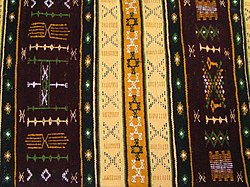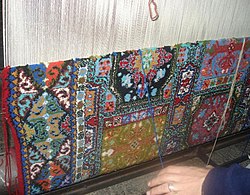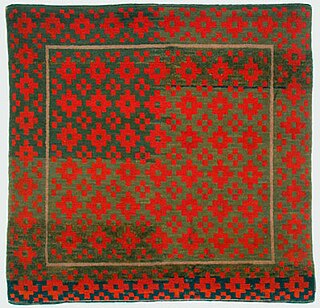
Berber carpets are carpets hand-woven by the Berber people in North Africa and the Sahara. The carpets come in traditional and modern designs, which are distinguished by different knotting patterns, dyes and fabric textures.

Berber carpets are carpets hand-woven by the Berber people in North Africa and the Sahara. The carpets come in traditional and modern designs, which are distinguished by different knotting patterns, dyes and fabric textures.

The origin of carpet weaving by the Berber populations dates back several millennia. The hand-spun cloth they created was named after the individual tribe, and they used natural fibres to create cloaks, rugs and other fabrics. [1] [2] [ self-published source ] [3]

Modern industrialized Berber carpets are distinguished by a loop pile construction type that gives a similar appearance to the distinct knot of traditionally woven Berber carpets. The modern carpets usually contain small flecks of dark colour on lighter shades of background colours resembling a natural undyed version of the traditional carpets. They generally consist of a plain colour mix with no pattern, and are relatively cheap and durable. Popular for areas with significantly heavy use such as offices. The distinctive knot texture and appearance of traditional hand-woven Berber carpets today are generally woven in brightly coloured designs that are different from other oriental rugs. [4] [ self-published source? ]
Handmade and usually homemade Berber carpets are still an active industry in many rural areas of Berber countries. Many Berber families earn their primary income from building-up carpets manually and selling them in local markets, merchants and tourists. Traditional Berber carpets differ from modern mass-produced Berber carpets that are usually found in industrialized markets. They often employ cultural designs and are typically made of natural materials
Today, there are numerous types of modern Berber carpet made from a wide variety of materials, Nylon, Olefin fibre and wool are the most frequently used materials. Tunisian Berber carpets and rugs, usually called "Mergoum", [5] which still preserve techniques inherited from ancestral weaving methods. Tunisian authorities are still controlling every piece to guarantee quality and that 'Berber' spirit in designs, patterns and symbols knotted so only wool is permitted with a total ban of any synthetic material, then each rug or carpet is sealed with a red wax sign (of Tunisian handicrafts authorities).
In other countries, Olefin is the most frequently used and most affordable material, and carpets with blends of the different materials are also available.
Berber carpet is highly durable and is often found in offices, schools, and other high traffic areas. It is stain resistant as well, and is generally more affordable than thicker plush carpets. To care about it is recommended by most professionals that Moroccan Olefin Berber should be cleaned using a low-moisture or dry cleaning process. Traditional steam cleaning with high alkaline detergents can cause potential pH burns in the olefin. These appear as large yellow or brown splotches. Yellow or brown spots also may be tannin bleed from the sugars in natural fibre carpets that are drawn to the top by improper drying usually caused by overwetting. There are carpet chemicals that can remove most of this yellowing or browning but they are very expensive, and it would be better to not get the yellowing or browning. A better, but more difficult, method may be to dry the carpet from the bottom. This method would generally require lifting up some of the carpet to install a carpet fan under the carpet, and using hot air, not just room temperature air. Regrettably, many of these stains can be permanent if not corrected immediately by a professional carpet cleaner. As with all carpets, Berber should be cleaned every 6 to 12 months to prevent permanent wear patterns.

A rug is a piece of cloth, similar to a carpet, but it does not span the width of a room and is not attached to the floor. It is generally used as a floor covering, or as a decorative feature.

A carpet is a textile floor covering typically consisting of an upper layer of pile attached to a backing. The pile was traditionally made from wool, but since the 20th century synthetic fibers such as polypropylene, nylon, or polyester have often been used, as these fibers are less expensive than wool. The pile usually consists of twisted tufts that are typically heat-treated to maintain their structure. The term carpet is often used in a similar context to the term rug, but rugs are typically considered to be smaller than a room and not attached to the floor.

A mat is a hard floor covering that generally is placed on a floor or other flat surface. Mats serve a range of purposes including:

Tibetan rug making is an ancient, traditional craft. Tibetan rugs are traditionally made from Tibetan highland sheep's wool, called changpel. Tibetans use rugs for many purposes ranging from flooring to wall hanging to horse saddles, though the most common use is as a seating carpet. A typical sleeping carpet measuring around 3 ft × 5 ft is called a khaden.

A Persian carpet or Persian rug, also known as Iranian carpet, is a heavy textile made for a wide variety of utilitarian and symbolic purposes and produced in Iran, for home use, local sale, and export. Carpet weaving is an essential part of Persian culture and Iranian art. Within the group of Oriental rugs produced by the countries of the "rug belt", the Persian carpet stands out by the variety and elaborateness of its manifold designs.

Gabbeh or gabba carpets are a traditional variety of Persian carpet. Gabbeh is known as gava in Kurdish and Luri and is also called khersak (خرسک) in Bakhtiari, literally meaning a "bear's cub". Traditionally a sleeping rug, a gabbeh is a hand-woven pile rug of coarse quality and medium size characterized by an abstract design that relies upon open fields of color and a playfulness with geometry. This type of rug is popular among the populations of the Zagros Mountains of Iran, including Kurdish, Luri and Qashqai people. The gabbeh is usually crafted by women.
An oriental rug is a heavy textile made for a wide variety of utilitarian and symbolic purposes and produced in "Oriental countries" for home use, local sale, and export.
Milas carpets and rugs are Turkish carpets and rugs that bear characteristics proper to the district of Milas in Muğla Province in southwestern Turkey. There are also a number of variants within the definition of Milas carpets. These variants are called under such names as Ada Milas, Patlıcanlı, Cıngıllı Cafer, Gemisuyu, and Elikoynunda, depending on the style, colors and other characteristics.

Anatolian rug is a term of convenience, commonly used today to denote rugs and carpets woven in Anatolia and its adjacent regions. Geographically, its area of production can be compared to the territories which were historically dominated by the Ottoman Empire. It denotes a knotted, pile-woven floor or wall covering which is produced for home use, local sale, and export. Together with the flat-woven kilim, Anatolian rugs represent an essential part of the regional culture, which is officially understood as the Culture of Turkey today, and derives from the ethnic, religious and cultural pluralism of one of the most ancient centres of human civilisation.

Hereke carpets are Turkish handmade carpets produced and sold in Hereke, a coastal town in Turkey. For a long time, they used to be produced only in Hereke, 60 km from Istanbul. The materials used are silk, a combination of wool and cotton, and sometimes gold or silver threads.

A knotted-pile carpet is a carpet containing raised surfaces, or piles, from the cut off ends of knots woven between the warp and weft. The Ghiordes/Turkish knot and the Senneh/Persian knot, typical of Anatolian carpets and Persian carpets, are the two primary knots. A flat or tapestry woven carpet, without pile, is a kilim. A pile carpet is influenced by width and number of warp and weft, pile height, knots used, and knot density.

Ryijy is a woven Finnish long-tufted tapestry or knotted-pile carpet hanging.
Iranian handicrafts are handicraft or handmade crafted works originating from Iran.

A Turkmen rug is a type of handmade floor-covering textile traditionally originating in Central Asia. It is useful to distinguish between the original Turkmen tribal rugs and the rugs produced in large numbers for export mainly in Pakistan and Iran today. The original Turkmen rugs were produced by the Turkmen tribes who are the main ethnic group in Turkmenistan and are also found in Afghanistan and Iran. They are used for various purposes, including tent rugs, door hangings and bags of various sizes.
A Pakistani rug, also known as Pakistani carpet, is a type of handmade floor-covering heavy textile traditionally made in Pakistan and is used for a wide variety of utilitarian and symbolic purposes. Rug/carpet weaving is an essential part of Pakistani culture and Pakistani art.
Moroccan rugs are the weaves, carpets, and textiles that have been traditionally hand-woven in Morocco. Rugs have been woven by the indigenous people of Morocco since the Paleolithic Era. Traditionally, Moroccan rugs have been woven by tribal peoples for their utility rather than for decorative purposes. Twentieth-century Moroccan rugs are widely collected in the West, and are almost always woven by tribes people who do not seek nor possess formal artistic training.
Varamin carpets and rugs or Veramin carpets and rugs are carpets and rugs woven in city of Varamin and its surrounding area, southeast of Tehran. Many rug and carpet experts see Varamins as being among those Persian carpets most authentic in terms of traditional style and motif.
The Bakhtiari rug, along with other weavings, is a major artform of the Bakhtiari tribe, located in Chahar Mahaal and Bakhtiari, Iran. Since the early 19th century, Bakhtiari rugs have been exported around the world.
DOBAG is the Turkish acronym for "Doğal Boya Araştırma ve Geliştirme Projesi". The project aims at reviving the traditional Turkish art and craft of carpet weaving. It provides inhabitants of a rural village in Anatolia – mostly female – with a regular source of income. The DOBAG initiative marks the return of the traditional rug production by using hand-spun wool dyed with natural colours, which was subsequently adopted in other rug-producing countries.

Kashmiri handicrafts is a traditional art of Kashmiri people and artisans who make, craft, and decorate objects by hand. Ganderbal, and Budgam are the main districts in central Kashmir which have been making handicrafts products since ages. The rest of its districts, including Srinagar, Ganderbal, and Budgam are best known for its cultural heritage which extends handicraft industry in Jammu and Kashmir, India. Embroidery is an integral part of many Kashmiri handicrafts, shawls, carpets and Kashmiri ladies pheran are adorned with intricate embroideries or flower styles made of thin metal threads and this kind of embroidery is known as 'Tille' in Kashmiri language. Embroidery work is done by both men in women in the region conventionally.